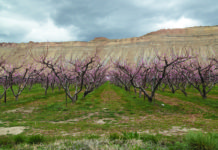In sports, coaches are always saying to “learn your fundamentals” so that you make fewer mistakes and are able to fully perform in that said sport. This mantra rings true for outdoor adventures, and the most fundamental, the most basic outdoor activity, is the day hike.
The day hike is typically the first true experience with nature that people get. Whether that be a two-mile loop, a hike up to the peak of the local mountain, or a 20-mile trek through the woods, hikes are the base of any outdoor activity, as many of the more fun and harder trips include hiking to some degree.
In hiking, the fundamentals all rely on what you bring with you, plus a couple of rules to follow as a prevention of death in the wilds. The rules are less variable and much easier to depict, so they will be addressed first.
The most important rule of hiking, and truly any excursion, is to let someone know where you are going and how long you plan on being gone for. Any faltering in this rule results in an 127 Hours scenario, and I think it is safe to assume that most people want to keep both of their arms. Even if you are going with another hiker, a person separated from your excursion has to know so that if you do get lost or stuck somewhere, they can call the rescue patrol and hopefully come to save the day.
The second rule is to always check the weather before heading out. If the plan is to summit a mountain and there is a ton of storm clouds encircling the peak, it is best to stay at home and not get zapped by a bolt of lightning. Not only can it be lifesaving, but it gives a tell as to what level of clothing warmth will be required to stay comfortable.
The last rule is to simply respect Mother Nature. Instead of carving into trees and painting on rocks, just enjoy the experience then and there. The more that one respects the wilderness they are in, the less likely they are to get into a sticky situation, pun intended. Realize that the humble Mother Nature could snuff out your life with a little falling tree here, a rockslide there, or a cougar under the bushes there. Respecting nature is key to any hike and it not only could keep you safe, it keeps the wilds beautiful for others to come and enjoy.
Now that the boring rules are out of the way, we get to move onto the fun part: what to pack. Now for every individual, packing needs are vastly different and need to be specially tailored to them. I, for example, need to have an excess amount of water, at least two liters, while my friend is only ever thirsty for one liter. Not to mention that these are all my personal packing items due to my experiences and are always evolving as I do more outdoor activities.
The water bottle is the most important item to pack, what with dehydration killing people in two days and all that fun stuff. Nalgenes are the classic favorite as they are very sturdy. The basic model contains one liter, fits nicely into backpacks, and is highly sticker customizable. Finding a great water bottle is so essential to have a good time on any hike and to keep healthy and happy.
The next item that I always pack is a water purifier. There are several types of purifiers, I use the Steropen, but they all essentially do the same thing: purify water. While this item, admittedly, isn’t necessary for a short two-mile hike and has a much more pragmatic function on backpacking trips and 15 miles plus, it is one of my favorites regardless. One of the best feelings in the world is to fill up a bottle full of freshly purified mountain water that is ice cold from the elevation and has no plastic taste found in imitation mountain plastic water bottles. So while not essential, a purifier is definitely a must pack.

The next is the safety equipment. This includes rope, a first aid kit, flashlights, emergency blankets, etc. These are essential to pack for the “what if’s” that could occur. What if you get lost and it is cold? Well, I’ve got an emergency blanket to keep me warm. All of these safety units are simple precautions, and most of the time go unused. However, it is much better to be ready for disaster than to be up a creek without a paddle.
A little snack goes a long way when you’re on top of a mountain and are feeling quite pooped. Packing some trail mix, granola bars, fruits, or whatever light and packable food you prefer is a must. They offer a great source of energy and can turn just about any frown upside down.
An extra layer is the next essential packing item. The weather, despite being checked, is always subject to change and when you get higher in elevation, the quicker it does so. Not to mention that as one goes higher, the colder it gets, so an extra hoodie and beanie feel fantastic when the 60-degree weather suddenly drops to 30 after an hour of hiking. Preparing for the weather is well worth the extra weight in your pack and can make the difference to a fun hike that took a dark turn and a fun hike.
The last item is some type of memorabilia that holds sentimental value to you. Taking something on the trip just adds an extra benefit to hiking. I take my orange Nalgene on every hike, trip, anything that I have ever been on. I have also seen it bounce down to the edge of a cliff and stop right before plummeting “death” feet down. My friend takes a stick up to every mountain top and whittles it down to commemorate the summit. Having this extra trope to a hike makes it that much more special and it imbues that item with the memories that you have created, making it almost as essential as water.
These rules and basic packing list are perfect to guide you into having a great experience hiking. They also provide a base for beginners to start their own essential packing list while offering a couple aspects for the more experienced to adopt. In the end, the essentials boil down to the individual, so take what you will leave out whatever didn’t appeal and just get out there and make some memories hiking.



